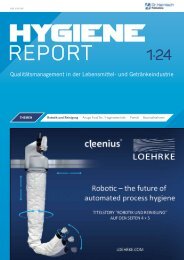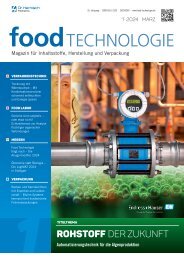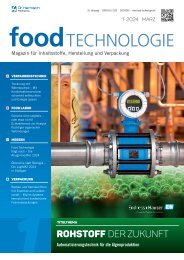GET – GREEN EFFICIENT TECHNOLOGIES – English Language
“GET – GREEN EFFICIENT TECHNOLOGIES” is the new independent media platform for energy supply, efficiency improvement and alternative energy sources and storage. There is still a high potential to save energy in industry. Efficiency is not only important for the profitability of a company, it is also target-oriented and saves resources. The importance of efficiency, especially in energy production, the role played by hydrogen, industrial processes, resource and recycling management, how energy can be stored and much more can be found in the new GET.
“GET – GREEN EFFICIENT TECHNOLOGIES” is the new independent media platform for energy supply, efficiency improvement and alternative energy sources and storage. There is still a high potential to save energy in industry. Efficiency is not only important for the profitability of a company, it is also target-oriented and saves resources. The importance of efficiency, especially in energy production, the role played by hydrogen, industrial processes, resource and recycling management, how energy can be stored and much more can be found in the new GET.
You also want an ePaper? Increase the reach of your titles
YUMPU automatically turns print PDFs into web optimized ePapers that Google loves.
Components<br />
Elastomer seals and biological fluids<br />
Is organic the solve-all solution?<br />
Applying elastomer seals with biogenic media<br />
Dipl.-Ing. (FH) Michael Krüger<br />
An ever-increasing number of biogenic<br />
fluids are being used in wide-<br />
reduce CO 2 emissions is also becom-<br />
protect the climate protection and<br />
ranging technical applications. Soaring<br />
numbers in fact. And for many Moves like this also help wean peoing<br />
an increasingly crucial argument.<br />
different reasons. Despite an applicable<br />
scope ranging from the che-<br />
products described are renewable<br />
ple off petroleum, since most of the<br />
mical process industry and related raw materials. Ultimately, though, the<br />
elements to usage in forestry, agriculture<br />
and water management, helping a range of biogenic media<br />
key thing making the difference and<br />
deploying these biogenic media break through may have been legislation<br />
in the form of EU directives.<br />
poses an enormous challenge to elastomer<br />
seals.<br />
Many public tenders, for example,<br />
prescribe the use of biogenic fluids in<br />
Biological fluids are environmentally construction vehicles.<br />
friendly, rapidly biodegradable and Even so, hurdles remain to the<br />
non-toxic media, most often produced<br />
from biomass. But why are ids with existing mineral oil-based<br />
wholesale replacement of such flu-<br />
more people using such fluids and media. For many components, some<br />
what is the main motivation? As well of the effects remain unknown and<br />
as the move to a greener approach numerous elastomer seals are also<br />
and avoid vehicles contaminating unsuitable for this application. Here,<br />
soil or bodies of water, the need to carburettor fuel E10 is introduced as<br />
Fig. 1: Biodegradable hydraulic fluids in mobile hydraulics. Photo: Fotolia/GHotz<br />
a result of regulatory market interventions<br />
and similarly, it triggers a<br />
different response in many components<br />
compared to conventional<br />
petrol. Accordingly, this impacts on<br />
the entire chemical process industry,<br />
directly and indirectly, when producing,<br />
storing and transporting media<br />
like these.<br />
Issues when deploying hydraulic<br />
fluids in sensitive ecosystems<br />
Generally speaking, the greenest fluid<br />
solutions involve no fluid escaping<br />
from machinery in the first place. But<br />
however cutting-edge the machines<br />
in place, leaks can still contaminate<br />
bodies of water and soil when stationary<br />
hydraulic systems like locks,<br />
weirs and hydroelectric power plants<br />
are used. The same applies when<br />
operating construction machinery,<br />
piste equipment in the mountains,<br />
and agriculture and forestry equipment.<br />
The key here is ensuring the<br />
hydraulic fluids and lubricants are<br />
free of substances with a critical ecotoxicological<br />
impact.<br />
This explains the increasing use<br />
of biodegradable hydraulic fluids in<br />
hydraulic drive technology. Beware<br />
however - they can severely attack<br />
conventional FKM seals and render<br />
long-term use virtually impossible.<br />
Biodegradable hydraulic fluids comprise<br />
either triglycerides, which are<br />
often vegetable oils (e.g. rapeseed oil)<br />
called HEES (hydraulic environmental<br />
ester synthetic) or synthetic esters<br />
known as HEES. These fluids are designated<br />
as class I pollutants.<br />
In modern hydraulics, more<br />
and more special high-performance<br />
hydraulic fluids are also being used.<br />
While they contain additives, they are<br />
not based on mineral oil. These substances<br />
constitute synthetic, anhydrous<br />
liquids (HFD), which have a<br />
higher density than mineral oil and<br />
are flame retardant. Examples include<br />
32 <strong>GREEN</strong> <strong>EFFICIENT</strong> <strong>TECHNOLOGIES</strong> 2022


















